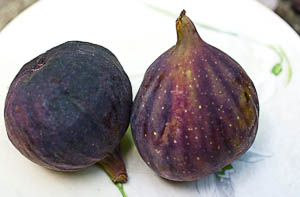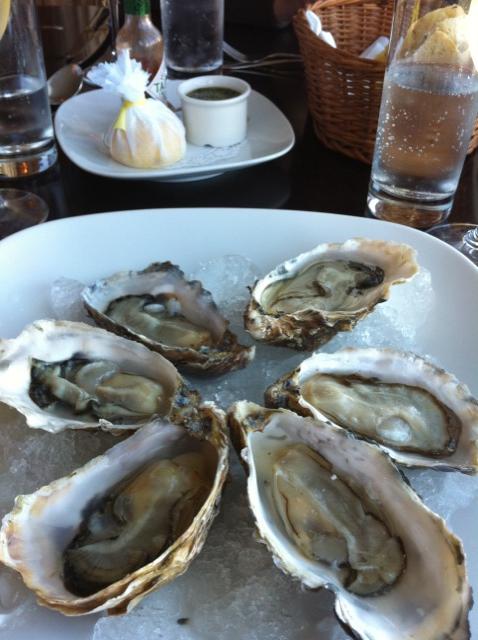You are currently browsing the category archive for the ‘Uncategorized’ category.
I once had a plate of wonderful figs. They were deep purple, with juicy pink insides and perfect sweetness and figginess. Very many times I have had figs that ranged from indifferent downwards. They look so pretty in the shop: purple and plump. But it’s very rare (at least in England) to find much flavour.
So what do you do when the memory of that long ago figgy perfection was called forth at the sight of this season’s supermarket offering, and you find yourself at home with a bowl of tasteless but beautiful fruit?
If the figs are half decent, then you could try eating them with a plate of prosciutto, so that the emphasis is on the ham and the pairing of flavours not just the fig. Figs are good with soft, creamy cheese, too, and if necessary you can add a little light floral or herbal honey to compensate for the lack of sweetness in the fruit, though you risk drowning out their flavour altogether. Walnuts and manchego cheese could be good to, but the truth is that these classical pairings really work best when the figs have enough flavour to match the foods they’re paired with.
With the quality of fig most of us have access to, drastic measures are called for. Deborah Madison is very clever with flavours: she pairs figs with caramelised sugar, orange flower water and cream. It won’t create fig flavour when you didn’t have any to start with, but your lucky guests will probably clean their plates very happily anyway.
Pour some sugar onto a plate. Cut your figs in half, and dip the cut side in the sugar, then put the figs, cut side down, in a hot cast iron frying pan (if you don’t have one of these, you need one). Let the sugar melt and sizzle for a minute or two, then turn the figs over for a minute. Remove them from the pan to your serving dish, turn off the heat, pour some double cream into the pan, and stir it to dissolve the sugar. Add a teaspoon or two of orange flower water, pour the sauce over the figs and serve.
If you want something even simpler, just cut the figs in half, sprinkle the cut side with sugar and put them under the grill until the sugar melts and they start to brown. These would go well with cream, mascarpone, ice cream …
Sadly, they still won’t taste like the perfect figs you remember from long ago. Maybe next time.
Fernand Point had three Michelin stars for decades and he trained a good proportion of all the French chefs who have had three stars since his time (he died in 1955). So why had I not heard of him until last week?
I came across a translation of his writings, printed together with a few chapters about the man and his restaurant (La Pyramide near Lyons). As you might imagine, cooking that collected so many stars isn’t necessarily suitable for the home kitchen. Not least because few of us have ready access to apparently limitless supplies of foie gras and truffles! Point didn’t suffer such any limitations, and he seems to have made full use of the opportunity to consume fine food and wine. What makes the book so fascinating is not just the recipes, which are fairly sketchy (he described them as “abbreviations for the working cuisinier”) but the larger than life person who still comes through so vividly more than fifty years after his death.
Apparently he started his breakfast each day with two magnums of Champagne at about 9am, while being shaved (he got up at 4:30, so his day was well underway by nine). “I like to start off my day with a glass of Champagne,” he said. “I like to wind it up with Champagne too. To be frank, I also like a glass or two in between.” His morning included the necessary preparations for serving lunch, and meticulous attention to all the details of food purchase, preparation and serving that are crucial to getting and keeping your Michelin stars, while consuming three chickens or so, washed down with more Champagne.
As well as collecting recipes, Point used to jot down thoughts or quotations that struck him:
 Butter! Give me butter! Always butter!
Butter! Give me butter! Always butter!
That which is very simple is not necessarily the least delectable. Take, for instance, sauerkraut. Yet, you still have to know how to prepare it.
After a cocktail or, worse yet, two, the palate can no more distinguish a bottle of Château Mouton-Rothschild from a bottle of ink!
If the divine creator has taken pains to give us delicious and exquisite things to eat, the least we can do is prepare them well and serve them with ceremony.
There are many people who claim to be good cooks; just as there are many people who, after having repainted the garden gate, take themselves to be painters.
When I stop in a restaurant I don’t know. I always ask to shake hands with the cuisinier before the meal. I know if he is thin, I’ll probably eat poorly. And if he is both thin and sad, the only hope is in flight.
Cookbooks are as alike as brothers. The best one is the one you write yourself.
I have been so well nurtured throughout my life that I’m sure to die completely cured.
Here’s a sample recipe from the book, Ma Gastronomie:
Coq en pâte Antonin Carême
Prepare a forcemeat consisting of equal quantities by weight of chicken livers and foie gras. Bind the forcemeat with a whole egg, add a little Madeira wine and some diced truffles. Season a nice plump rooster and stuff it with the forcemeat. Roast the bird about thirty minutes and let it cool a little. Cover it with a pastry dough and put it in the oven for at least an hour. Serve the rooster with a very good sauce Périgueux, along with a julienne of truffle.
Definitely a man with style!

That which is very simple is not necessarily the least delectable. Take, for instance, sauerkraut. Yet, you still have to know how to prepare it.
Aubergines are beautiful, with that deep purple colour, and those alluring curves. Whether they’re smooth, ridged, round or elongated, they’re gorgeous. And when you cook with them they add a luscious richness that’s unlike anything else. But have you ever cooked a recipe that starts by frying aubergine slices? I’ve tried them on numerous occasions. No matter how carefully I follow the instructions, I always seem to end up with a kitchen full of smoke, a burnt fat smell that lingers for days, and aubergine that’s soaked up pints of oil and usually releases it later so that the final parmigiana or moussaka ends up swimming in oil. Not to mention the cost of using half a bottle of olive oil to fry your aubergines.
The first solution I tried was a technique that Marcella Hazan uses in a wonderful pasta sauce that combines aubergines with red and yellow pepper. She very lightly sautées the aubergine, then adds just a little liquid, covers the pan, and allows it to steam until it’s fully cooked. It works very well in that context, but for some dishes, like parmigiana di melanzane, it somehow allows the acid notes to express themselves too strongly, and isn’t quite rich enough.
 The method I use now came from Paula Wolfert. I slice the aubergine about 1cm, or just under ½” thick, brush the slices with olive oil, on both sides (you can be as generous or as stingy as you like with the oil – I prefer to be fairly generous). Put the slices on a baking tray, and cook at 220°C/430°F for 25 minutes, turning the slices over half way through.
The method I use now came from Paula Wolfert. I slice the aubergine about 1cm, or just under ½” thick, brush the slices with olive oil, on both sides (you can be as generous or as stingy as you like with the oil – I prefer to be fairly generous). Put the slices on a baking tray, and cook at 220°C/430°F for 25 minutes, turning the slices over half way through.
For recipes like parmigiana di melanzane, where the slices are usually coated in breadcrumbs, it works perfectly well to sprinkle a few breadcrumbs over the slices as you put the dish together. By the time they’ve been coated in tomato sauce and baked, it doesn’t make too much difference whether the breadcrumbs were initially cooked with the aubergine or not.
You can use the baked slices in parmigiana, moussaka, etc, or drizzle them with a bit more olive oil and add them to your antipasti; with, or without, some good mozarella.
The supermarket had pomegranates again yesterday! Their season is from now until January, so they haven’t been around for a few months. There’s something seductive about pomegranates. The myths and symbolism seem stronger than for other foods. I know about the temptation in the Garden of Eden, but I don’t think about it every time I see an apple. Somehow pomegranates keep their air of ancient mystery even when you can buy them in the supermarket.
 I have childhood memories of picking out the grains with a pin (I’m not sure why, because these days they seem to come out perfectly easily without any pins being needed), and of the wonderful melograno bath oil from the Farmacia Santa Maria Novella in Florence, but there are more evocative images lingering in the air too, of the story of Persephone being kidnapped and taken to the Underworld by Pluto. The Fates decreed that she could not return if she had eaten any food, and she had eaten a few pomegranate seeds during her time in the Underworld, so a compromise was made allowing her to return to Earth for half of the year, and spend the other half in the Underworld (the proportions of time in each place vary in different versions of the story). During Persephone’s time in the Underworld, her mother, Ceres, goddess of agriculture, mourns, and the Earth is barren, apart from the pomegranate, the fruit of the Underworld.
I have childhood memories of picking out the grains with a pin (I’m not sure why, because these days they seem to come out perfectly easily without any pins being needed), and of the wonderful melograno bath oil from the Farmacia Santa Maria Novella in Florence, but there are more evocative images lingering in the air too, of the story of Persephone being kidnapped and taken to the Underworld by Pluto. The Fates decreed that she could not return if she had eaten any food, and she had eaten a few pomegranate seeds during her time in the Underworld, so a compromise was made allowing her to return to Earth for half of the year, and spend the other half in the Underworld (the proportions of time in each place vary in different versions of the story). During Persephone’s time in the Underworld, her mother, Ceres, goddess of agriculture, mourns, and the Earth is barren, apart from the pomegranate, the fruit of the Underworld.
It’s hard to resist the lure of such a fruit, but it’s not immediately obvious what to do with it when you get it home. A few seeds sprinkled on some Greek yoghurt are good, but there must be more than that!
One popular use is as a garnish for a warm salad of one of the richer meats, such as slow-roast lamb shoulder, or confit duck leg. Henry Harris makes a delicious version with a dressing of grated ginger, lemon, olive oil and poppy seeds, served with confit duck leg, with spring onions, walnuts, coriander, and a good scattering of pomegranate seeds. That combination of olive oil dressing, walnuts and pomegranates is very good.
 Pomegranates originated in the Middle East, and are found in dishes all around that area. Paula Wolfert’s The Cooking of the Eastern Mediterranean has several examples: with summer savory salad; with grilled red pepper strips and cumin; in a hot and sweet red pepper dip with walnuts… and even more recipes that use pomegranate molasses. There’s a delicious one where chicken breasts are stuffed with mozzarella and roasted with a glaze of pomegranate molasses.
Pomegranates originated in the Middle East, and are found in dishes all around that area. Paula Wolfert’s The Cooking of the Eastern Mediterranean has several examples: with summer savory salad; with grilled red pepper strips and cumin; in a hot and sweet red pepper dip with walnuts… and even more recipes that use pomegranate molasses. There’s a delicious one where chicken breasts are stuffed with mozzarella and roasted with a glaze of pomegranate molasses.
That should be enough to keep me going until they disappear in the new year.
I’ve always had mixed feelings about the idea of eating local and seasonal food. It appeals to the romantic and the purist in me. But I live in England, and while I enjoy some root vegetables and wintery stews, I don’t want to eat quite that much cabbage, or deprive myself of the lemons, spices and various other imports that brighten the winter months. I’ve always had a suspicion that the whole idea was invented by someone living in a place like California or Southern Italy.
Still, following the seasons does give a new appreciation for each food as it appears after its seasonal absence. I love broad beans, but I’m convinced that a good part of their appeal is that they’re only around for a few weeks of early summer. I can buy strawberries all year round, but the English summer fruits taste quite different from the imported winter ones. On the whole, I get more pleasure from my food if I avoid the watery winter berries.
Part of the romantic appeal of seasonality is that it evokes images of being in tune with nature and the seasons. Most of us these days don’t grow much of our own food. In fact the farmers’ market is the closest I usually get to the land! So it was a special treat this week to have some truly fresh food grown by my nephew and his gardening partner. Their offering nicely captured both sides of the local and seasonal question. This is England, we haven’t had the greatest summer this year, so not all of their crops thrived. They brought us carrots, onions, and the last of this season’s runner beans. Nothing exotic or flashy, but carefully grown, and eaten within hours of being picked. Even beyond the increasingly rare delight of carrots that taste of carrot, there’s a particular atavistic pleasure from food that’s grown, harvested, cooked by and eaten with family and friends.


